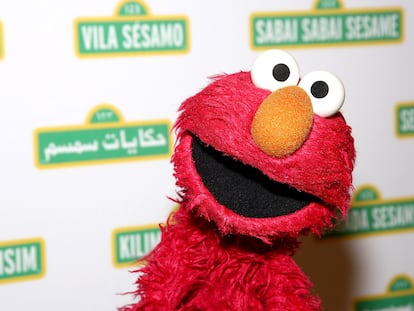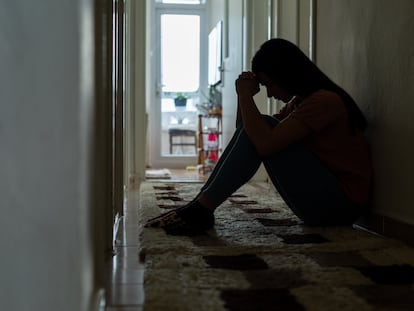When mental health becomes content: ‘We don’t need influencers, we need psychiatrists’
Psychologists and patients condemn the image of depression painted by social media. Some creators have gone from raising awareness to trivializing psychological problems and encouraging self-diagnosis
She looks for her reflection on her phone, but what she finds there is very different from what she sees every morning in the mirror. That makes her angry. Beatriz López, 47, is bothered by the way people talk about depression on social media. How they trivialize a topic that has directly affected her for 30 years. “Neither I nor my family knew what was happening to me back then,” she explains. Depression was a taboo; people stayed away from those who dared to break it. Nowadays, she admits, mental illnesses have gained prominence. “There is more talk, although not necessarily better,” she says. “Now it is being romanticized.”
Normalizing the conversation about mental health issues is a positive thing, but there is a huge difference between destigmatizing therapy – a personalized conversation with an expert – and turning it into content to get attention, likes and money. “Depression is an illness that must be treated by a specialist,” López says. “We don’t need influencers, we need psychiatrists.”
TikTok videos with the tag #mentalhealth have been viewed almost 44 billion times. This could be good news, but the important thing is not how much, but how it is talked about. In recent months, many accounts have moved from raising awareness to offering guidance and entertainment. There are mental health influencers, untrained people who have found an expanding market niche. “Talking about mental health is fashionable,” explains Luis Muiño, psychotherapist and disseminator in the podcast Entiende tu mente (in English: Understand your mind). “And I think it’s important to know it, to conceptualize it. Mental health has gone from being a taboo, to the opposite: it is talked about, sometimes too much. Because when something is fashionable, some people can draw on their experience to seek attention, assert themselves and say, ‘Hey, I’ve had it too.’ In some way it is taken as something that gives you status, something cool.”
Issey Moloney is an 18-year-old British influencer with more than seven million followers on TikTok. There, she combines videos about her beauty routines or her trips with jokes that link depression to eating pasta or lists in the vein of “Signs that you might have bipolar disorder.” In a 24-second video, she appears crying as she looks at the camera and lists symptoms such as “feeling empty” or “intense and short-lived relationships.” In the comments, several users accuse her of pathologizing being a teenager.
Borja Hiriart is a Chilean content creator with 2.5 million followers on TikTok. Among his most viewed videos, there is one in which the message “your little joke cost me my emotional stability” can be read as he fakes a crying fit. In others, he gives advice on how to help your girlfriend if she has anxiety, or lists “signs that your mental health is on the verge of collapse.” Both Hiriart and Moloney act out an emotional state, with performances, dramatic music and short, 10-word phrases. Psychological diagnosis adapted to the TikTok format.
“Swiftness can be useful if you are talking about a simple topic,” explains Muiño. “There are nuggets of information that can be given on TikTok. The problem is that content creators have to keep uploading videos, feeding their accounts, and analyzing complex things in 30 seconds is tempting, such as the gestural profile of a person with depression.” TikTok rewards these videos, which accumulate millions of views. Social media is designed to prioritize the content that provokes the strongest reactions, not the most accurate content. And depression sells.
@isseypovs Here’s some signs that you might have it
♬ original sound - shamerals
Depression is cool
Mental health has entered the conversation, and this is not limited to social media. According to the podcast search engine Listen Notes, more than 5,500 episodes have the word “trauma” in their title. Amazon produces more than 60,000 results when one searches for books on mental health. In interviews, actors, singers and celebrities of all stripes talk about how therapy has helped them become better people.
Philosopher and music producer Alex Kresovich analyzes references to mental health in contemporary music. In a 2021 study, he noted that their presence in rap songs over the last 20 years has increased in a surprising and constant manner. In another, he observed a similar phenomenon in pop. According to Kresovich, Kanye West’s 2008 album 808s & Heartbreak was a turning point. “It’s become really normalized,” he recently stated in an interview with The New York Times. “There is this idea that mental health is being discussed so much publicly that some neuroses, like depression, are almost being romanticized.”
The public is no stranger to this fashion, which has permeated society. It is no longer just the influencers talking about it; it is the users. It is all of us. Social networks are a loudspeaker that magnifies and distorts the conversation. Nowadays it is too easy to make private feelings public and find people who validate them through interactions, hearts or thumbs up, and this can be addictive. This is the only way to explain viral phenomena such as what happened with Sesame Street’s Elmo, who recently posted an innocent message on his X account: “Elmo is just checking in! How is everybody doing?” The post drew thousands of dramatic responses that spoke of depression, anxiety and suicide attempts.
The American psychologist Scott Lyons warns in his book Addicted to Drama that the attention economy is fostering a spiral of stress and heightened feelings. We know from research that being more dramatic on social media gets more attention and more likes, he explains. It is a reinforcement. In this way, and without being fully aware, we become part of the problem. 60% of young people who use TikTok end up self-diagnosing a mental health problem. Many of those who do so end up joining the online conversation, sharing experiences with other people suffering from the same problems. Creating groups. “That’s what we call a dramatic union. If we come together through a shared symptomatology and we feed each other, it is difficult for us to later want to give up the label and the relationships we get from it,” he reflects.
That is the difference between real, individual therapy, and the reductionist, viral, generic version that proliferates on the internet. Talking about personal problems and anxieties can have a healing effect, but when the conversation takes place on social media, it is amplified by algorithms and distorted by the attention economy, and it can have the opposite effect. As we talk more than ever about depression and anxiety, suicide rates and mental health issues continue to rise. Most of this public conversation takes place online, which encourages vulnerable people to surround themselves with conversations on the topic and go into algorithmic wormholes. This does not seem to be having any positive effects.
Sign up for our weekly newsletter to get more English-language news coverage from EL PAÍS USA Edition
Tu suscripción se está usando en otro dispositivo
¿Quieres añadir otro usuario a tu suscripción?
Si continúas leyendo en este dispositivo, no se podrá leer en el otro.
FlechaTu suscripción se está usando en otro dispositivo y solo puedes acceder a EL PAÍS desde un dispositivo a la vez.
Si quieres compartir tu cuenta, cambia tu suscripción a la modalidad Premium, así podrás añadir otro usuario. Cada uno accederá con su propia cuenta de email, lo que os permitirá personalizar vuestra experiencia en EL PAÍS.
¿Tienes una suscripción de empresa? Accede aquí para contratar más cuentas.
En el caso de no saber quién está usando tu cuenta, te recomendamos cambiar tu contraseña aquí.
Si decides continuar compartiendo tu cuenta, este mensaje se mostrará en tu dispositivo y en el de la otra persona que está usando tu cuenta de forma indefinida, afectando a tu experiencia de lectura. Puedes consultar aquí los términos y condiciones de la suscripción digital.
More information
Últimas noticias
Most viewed
- Reinhard Genzel, Nobel laureate in physics: ‘One-minute videos will never give you the truth’
- Oona Chaplin: ‘I told James Cameron that I was living in a treehouse and starting a permaculture project with a friend’
- Pablo Escobar’s hippos: A serious environmental problem, 40 years on
- Why we lost the habit of sleeping in two segments and how that changed our sense of time
- Chevy Chase, the beloved comedian who was a monster off camera: ‘Not everyone hated him, just the people who’ve worked with him’











































